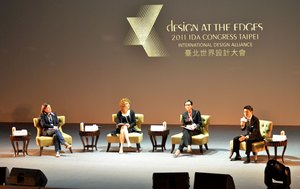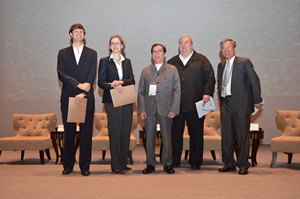International, local designers exchange ideas at Taipei IDA Congress
By Yali Chen During the 3-day event, international and local designers got together in Taipei to share their works and exchange ideas. Esko Aho, Prime Minister of Finland from 1991 to 1995, presented a lecture through video conferencing in the first keynote session of the 2011 IDA Congress in Taipei. The topic of his speech was modeling the experience of Northern Europe to drive sustainable economic development of nations. “Vision, execution and leadership are critical for governments and businesses,” Aho said. “Vision without execution is a daydream, and execution without vision is a nightmare.” With a long and distinguished career in public service, Aho joined Nokia in 2008 to serve as Executive Vice President of the Corporate Relations and Responsibility Department. He has also overseen the company’s global policies and activities in sustainable development and social responsibility. Later in 2000 he joined Harvard University as a lecturer. Nokia is well-known for its mobile revolution. Aho said that the earliest cell phones were heavy and bulky, but in 1987 Nokia launched the Mobira Cityman – the first handheld mobile phone for NMT networks. This handset product successfully entered the global market of mobile technology, Aho noted, adding that Nokia has witnessed huge changes in the mobile revolution over the past three decades. Finland prides itself on its soft power in the mobile revolution thanks to its education, investments and access to open markets. “Tech design lies in our DNA. We need designers’ support to integrate vision and execution and to help create new schools, hospitals and health care systems,” Aho said. To summarize his lecture, Aho quoted Steve Jobs as saying that technology alone is not enough, it is technology married with the liberal arts, married with the humanities, that yields the results that makes our hearts sing. Kohei Nishiyama of Japan worked as moderator for the first keynote session of the 2011 IDA Congress in Taipei. The founder of CUUSOO.com won the Japanese Good Design Award in 2001, serving as a judge on the Good Design Award committee from 2002. He is also a member of the international selection committee for the 2014 designation of the World Design Capital (WDC) by Icsid. Other panelists included Emily Campbell of the UK, Nila R. Leiserowitz of the US, and Valerie Jacobs of the US. Leiserowitz, Managing Director of Gensler, has spent more than 30 years pushing the limits of interior design and workplace performance strategy. Renowned for her workplace design innovation, Leiserowitz has won numerous awards from IIDA, AIA and ASID, including ASID’s Designer of Distinction Award in 2007. Jacobs, Vice President and Group Director for LPK Trends, is an experienced design forecaster focusing on the development of trend analysis for client brands. Chen Wen-long of Taiwan, Nila R. Leiserowitz of the US and Robert L. Peters of Canada delivered speeches at the Design Salon B1 on the first day of the 2011 IDA Congress in Taipei. They discussed how designers try to maintain a balance between economic development and sustainable design. A specialist in industrial design and winner of many awards in design circles, Chen works as CEO of Taiwan-based Nova Design Co., which has become one of the largest independent design consultancies in the Greater China area. Chen said that since its founding in 1988, Nova Design has worked with SYM Taiwan – one of the most popular brands of scooters and motorcycles in the country. After developing many famous products that won over local consumers, they used their successful business model to enter the scooter market in Vietnam. In 1984 China opened its door to international carmakers including Volkswagen. Chinese people grew richer thanks to the period of strong economic growth from 1990 to 2010. Robust demand for high-end products also attracted many global design brands to tap into the Chinese market. But lower-income consumers such as farmers, who account for 80 percent of China’s population, cannot afford high-end products like iPhones. Chen suggests that designers from Taiwan, China and other countries take the strong potential for lower-end products into consideration in this and other markets. Active in global design consulting, Peters served as President of Icograda from 2001 to 2003. “Good design is good business,” he said, adding that companies should take more responsibility for promoting sustainable design. The lifelong humanist also believes that a huge amount of environmental damage has been caused by people seeking a convenient lifestyle and using too many plastic products. “I counted 7 different plastic elements in my lunch bag. It’s unbelievable,” Peters said. “Designers need to think about a better way to create an eco-friendly and sustainable future.” He added: “Do more with less.” In his speech titled “The Design of the Internet: Vision for the Future, Culture in the Heart,” Lam started with the example of music players. In 1979 Sony introduced the Walkman – the world’s first mobile music player, but it was replaced by the iPod and iTunes launched by Apple in 2001. Citing another example of evolution in electronic equipment from black and white TV to color TV, cable TV, satellite TV, digital TV and HDTV to streaming TV, Lam said, “The development of technology is beyond our imagination. How do we change to survive in the era of disruptive innovation?” “Only Generation ‘C’ can survive in the hyper-connected world,” he said, adding that the people in this new emerging generation are connected, communicating, computerized, content-centered and community-oriented. “Growing up in the world of Google, Facebook, Twitter and Amazon, they are Homo Interneticus and netizens, not Homo sapiens or citizens.” But disruptive innovation does not always succeed. Lam believes that innovators need to embrace failure, fear success, think out of the box, see things differently and think of humanity. He called Steve Jobs a humanistic engineer. “The road to success is paved with a thousand tiny failures. Jobs went wrong very often, but he learned from failure and took risks,” said the Chairman of the Quanta Culture and Education Foundation. “He also cared about designing for humanity.” The Director of User Experience at Siemens Corporate Research in Princeton, New Jersey, Ruth Soenius, agreed that design is not just about technology or the Internet, but about humanity. “It’s a big challenge for future designers to connect culture and context. But keep it simple in every way, because users like simple products,” she said. So how do people live a simple and better life? Lam noted: “Go back to nature and humanity.”
STAFF REPORTER Beating a field of rivals that included Paris, Melbourne and Montreal, Taipei stood out among 19 cities representing 13 countries to win the right to host the 2011 IDA Congress Oct. 24-26.
Beating a field of rivals that included Paris, Melbourne and Montreal, Taipei stood out among 19 cities representing 13 countries to win the right to host the 2011 IDA Congress Oct. 24-26. Campbell was the first head of design and architecture for the British Council Arts Group. For twelve years her critical expertise in design has enhanced Britain’s international reputation for creativity and expanded the international perspective of design in the UK.
Campbell was the first head of design and architecture for the British Council Arts Group. For twelve years her critical expertise in design has enhanced Britain’s international reputation for creativity and expanded the international perspective of design in the UK.Barry Lam, Chairman of Taiwan-based Quanta Computer Inc., delivered a talk in the second keynote session of the 2011 IDA Congress in Taipei. Ranked in Business Week’s Top 25 Managers in 2002 for making Quanta the No. 1 notebook producer in the world, Lam is considered a pioneer in the field of innovative electronic products. Over the past few years he has devoted himself to promoting interaction in the digital economy, culture and humanity.

![Taiwan.gov.tw [ open a new window]](/images/egov.png)
